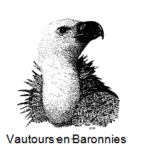Vultures comeback in the Baronnies
Vautours en Baronnies
Vultures disappeared from the southern Alps in the 19th century, due to direct persecution and indirect poisoning at a time when access to firearms increased and people were aiming to eradicate wolves and other predators. Times have changed, and people have now realised that vultures play an important ecological role. In this context, Vautours en Baronnies was created in 1993 to work with local people to bring back vultures to the Baronnies.
After over a century of absence, the four European species of vulture are once again present in the skies of the Baronnies, a mountain range in the Dauphiné Alps of France. Thanks to a reintroduction initiated in 1996, the area is now home to the largest colony of griffon vultures in the Alps, with over 300 breeding pairs.
The cinereous vulture was also reintroduced, starting in 2004. Finally, bearded vulture are back following reintroductions started in 2010 in the Vercors and 2016 in the Baronnies, Attracted by the presence of the other species, the Egyptian vulture has reappeared spontaneously!
This makes the Baronnies one of the few places in Europe where one can see all four native European vulture species.

Vultures disappeared from the southern Alps in the 19th century, due to direct persecution and indirect poisoning at a time when access to firearms increased and people were aiming to eradicate wolves and other predators. Times have changed, and people have now realised that vultures play an important ecological role. In this context, Vautours en Baronnies was created in 1993 to work with local people to bring back vultures to the Baronnies.
After over a century of absence, the four European species of vulture are once again present in the skies of the Baronnies, a mountain range in the Dauphiné Alps of France. Thanks to a reintroduction initiated in 1996, the area is now home to the largest colony of griffon vultures in the Alps, with over 300 breeding pairs.
The cinereous vulture was also reintroduced, starting in 2004. Finally, bearded vulture are back following reintroductions started in 2010 in the Vercors and 2016 in the Baronnies, Attracted by the presence of the other species, the Egyptian vulture has reappeared spontaneously!
This makes the Baronnies one of the few places in Europe where one can see all four native European vulture species.



